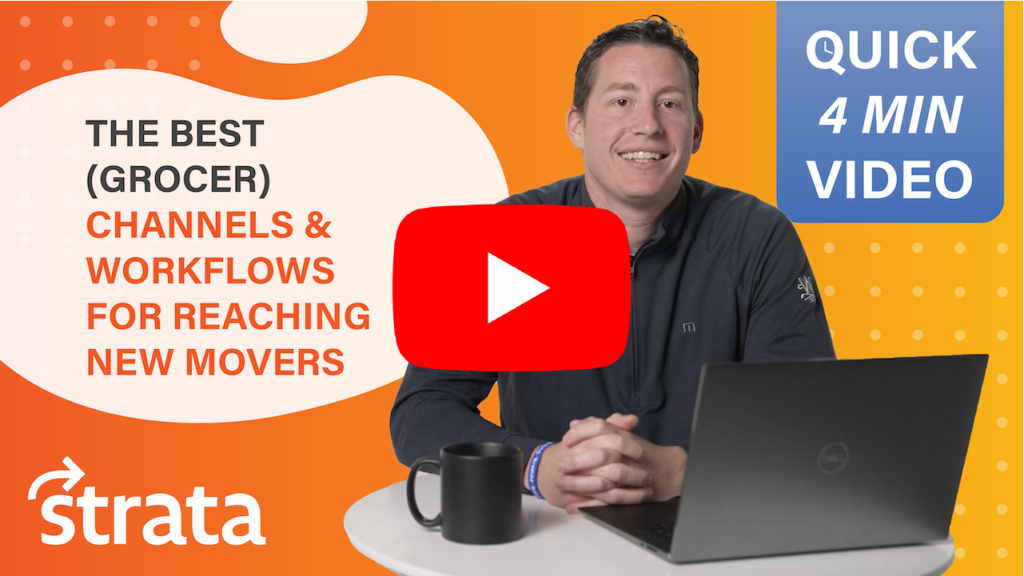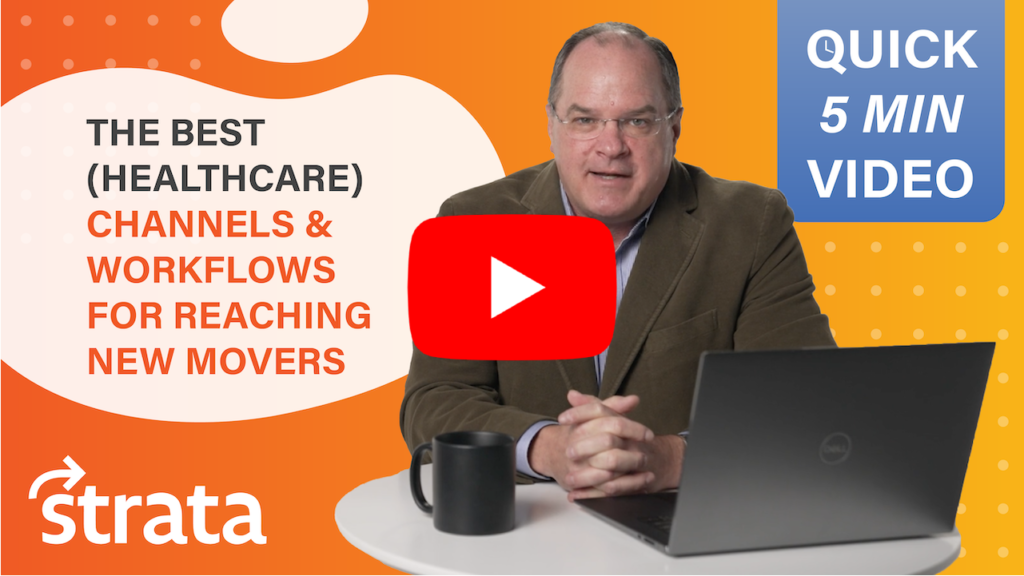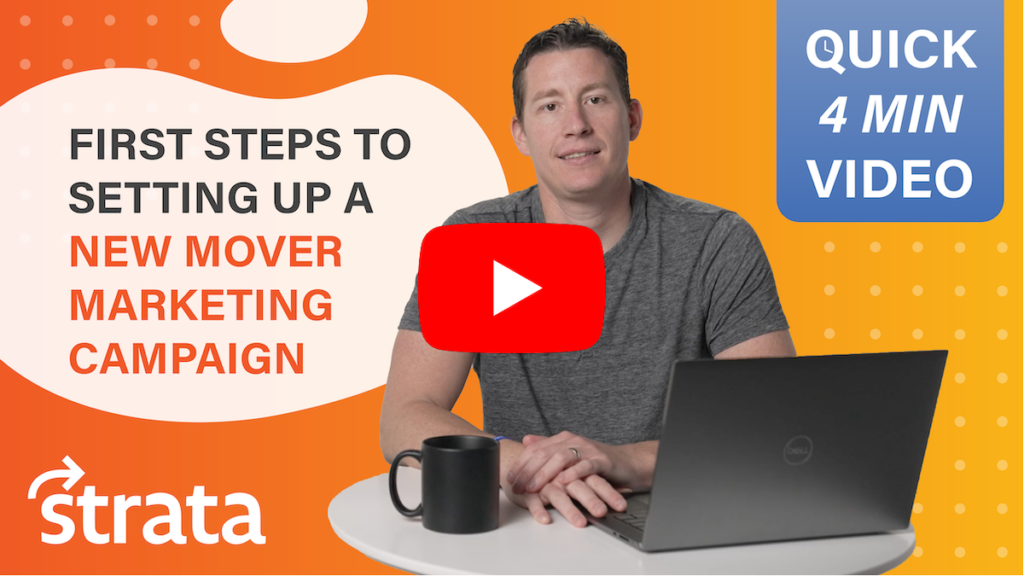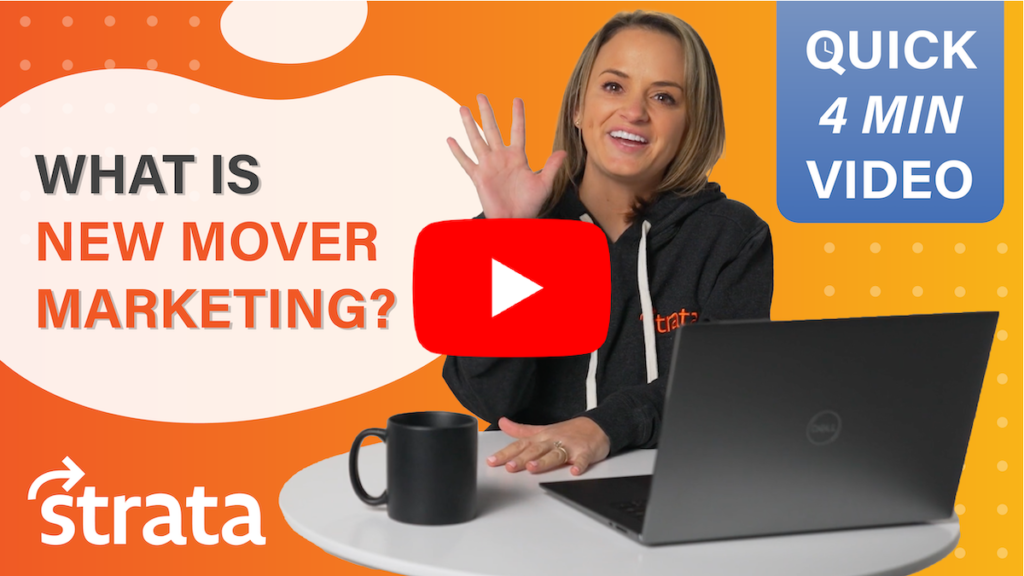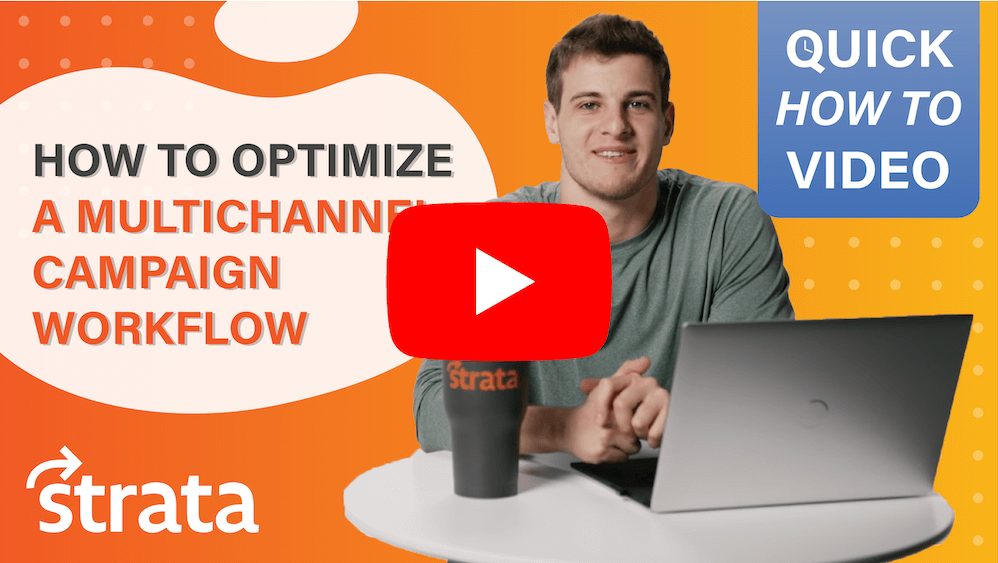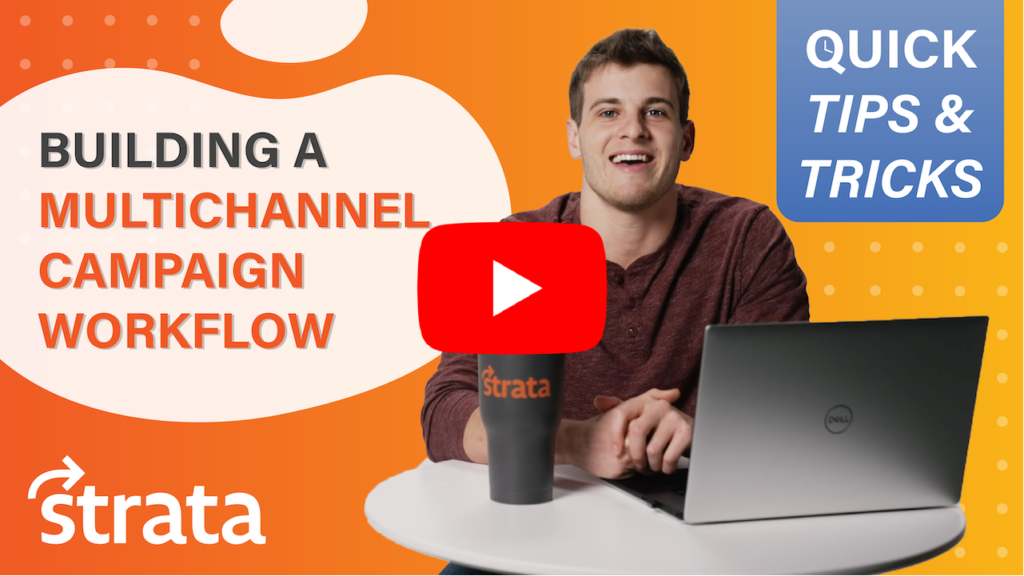A Strata YouTube Channel Original
In our last few blogs (and their corresponding YouTube videos) we’ve gone over the basics of new mover marketing, how to choose the right partner, and some steps to get started. Now, it’s time to take a deeper dive into how you can specifically utilize new mover marketing in the grocery industry and what channels and workflows work best.
A Quick Review of New Mover Marketing
To give you a brief refresher, new mover marketing is a specific, niche marketing tactic that’s designed to reach new residents in your area. It’s one of the most effective ways to bring in new customers that have just recently entered your specific target market. When it comes to new movers, they’re nobody’s customer, yet – so it’s an effective tactic to make a good first impression at the same time they’re looking for your product or service.
What do New Residents Really Want?
To answer the question, new residents are looking for “reliables”. These are goods and/or services that new movers can depend on daily, weekly, monthly, or even yearly. Since they’re new to the area, they’re usually unsure where to start. When it comes to grocery stores, sometimes there can be almost too many options for consumers to choose from. Because of this, you, as a grocery store, are in constant competition with other stores near you. That’s why it’s so important for your grocery store to be the first to reach out and make the consumer aware of your store – before competitors – and show them you’re close by. With immediate outreach, they’ll see you care, are convenient, and have quality goods.
The Best New Mover Channels for Grocers
We’ve deemed ourselves experts in new mover marketing all around – and we’re very practiced in some of the best channels and workflows for grocers (specifically) to reach new movers. One of the best channels you can take advantage of is direct mail. We know direct mail to be vital to the success of new mover campaigns, especially those of grocery stores. When mail is executed correctly, with personalization and attribution tactics, it can cut through all the digital noise and stand out in the mailbox. As we’ve mentioned in past blogs and videos, the average response rate for direct mail can be up to 50% more effective than those of email blasts, so it’s definitely worth your time and money!
Like we hinted at above, not all direct mail is created equal, so we suggest that those in the grocer industry send a “welcome handshake”. This is either a 6×9 or 6×10 postcard or bifold that allows your store to be introduced and represented in the best way possible. Again, the key to a good direct mail campaign is making sure it’s personable and actionable. With personalization and calls-to-action, you can welcome new movers to the neighborhood by first name and provide a personalized offer, which they can access by QR code or PURL. Another option? Provide a personalized coupon that they can redeem in-store, upon their first visit. If you want to go a step further in terms of personalization, include a map that shows the location of your store relative to their new residence. Generally, you want to make it as easy and enticing as possible for new movers to choose and visit your store.
What’s Next?
With this quick read, you now have a look into one of the top grocery industry channels to utilize for your next new mover campaign. But – it doesn’t stop there! We still have more suggestions when it comes to the best channels and workflows for grocery establishments like yours. Head over to our YouTube channel, where you’ll hear these suggestions from Connor, a member of Strata’s Strategic Sales Team. Or, if you’re ready to take these new mover marketing steps with Strata, contact us today.
A Strata YouTube Channel Original
In our last three blogs (and their corresponding YouTube videos) we’ve gone over the basics of new mover marketing. It’s important to remember that new mover marketing can differentiate between industries, so the best plan of action for specific business types may not be the same as others. In this blog and its corresponding YouTube video, we’re taking a deep dive into how you can specifically utilize new mover marketing in the healthcare sector – as well as what channels work best.
A Quick Refresher on New Mover Marketing
To give you a brief refresher, new mover marketing is a specific, niche marketing tactic that’s designed to reach new residents in your area. It’s one of the most effective ways to bring in new customers that have just recently entered your specific target market. When it comes to new movers, they’re nobody’s customer, yet – so it’s an effective tactic to make a good first impression at the same time they’re looking for your product or service.
What are New Residents Actually Looking For?
To answer the question, new residents are on the lookout for “reliables”, which are goods and services they can depend on daily, weekly, monthly, or even yearly. The healthcare industry is full of these “reliable” services – and these services are much different than those of grocery stores and restaurants. Customers will more likely choose any grocery store or restaurant to at least check out and maybe turn into their new “go-to” spot. If it ends up that they don’t like the spot – it’s really no big deal. They’ll move on and find another. With healthcare, most people don’t want to “try out” 4 or 5 doctors/healthcare services until they find one they like. In general, it’s a lot more work to fill out paperwork and questionnaires at healthcare offices, and most people only want to do that once.
Potential patients want to feel important and valued, so it’s key to be the first to reach out. When you reach out – first, the potential patient can get to know you and your system, while ensuring that you’ll be there in their times of need.
Best New Mover Healthcare Campaign Channels
Based on our years of expertise and data collection, we’ve compiled a list of what we think are the best channels to utilize when reaching out to new movers to hopefully turn them into patients. The first channel we recommend utilizing is direct mail. The average response rate for direct mail can be up to 50% more effective than that of an email blast, when done correctly. For a direct mail campaign to be done correctly, there must be some aspect of personalization, multiple response vehicles (such as QR codes and PURLs) and accurate data lists. The key to quality, effective direct mail is incorporating more than one touchpoint. If you’re able to send more than one direct mail piece, your potential patient will be consistently reminded of you and your business.
The next channel we recommend utilizing? Digital advertising. Targeted, focused ads can show potential patients that you’re close by and welcoming new patients. A benefit to using digital advertising? The level of precision. With digital ads, you can measure performance through impressions served and ad clicks. If you pair with the right new mover marketing partner for your business, you’ll be able to see how many and which customers converted due to your digital ads. This real-time data is vital to the success of your campaigns. It allows you to see what campaigns are working, which ones are not, and make the necessary adjustments on the fly rather than once the campaign is over.
What’s Next?
You now have some potential, optimal channels to utilize as a part of your next new mover campaign. But it doesn’t stop there! We still have more suggestions. Head over to our YouTube channel (by clicking the thumbnail below) to hear from Rob, a member of Strata’s Strategic Sales Team. He’ll fill you in on the rest of our channel recommendations. If your healthcare system is ready to take these new mover marketing steps with the team at Strata, contact us today.
A Strata YouTube Channel Original
In our past two blogs and their connected YouTube videos, we’ve given you a ton of basic information on new mover marketing. Now, it’s time to get into the first steps of starting a new mover marketing campaign. If you’re not super familiar with new mover marketing, it can be difficult to determine where and how to start, but we’ll lead you through the first things to do and ensure you’re well prepared.
A Quick Refresher on New Mover Marketing
To give a brief refresher, new mover marketing is a specific, niche marketing tactic that’s designed to reach new residents in your area. It’s one of the most effective ways to bring in new customers that have just recently entered your specific target market. When it comes to new movers, they’re nobody’s customer, yet- so you must make a good impression at the same time they’re looking for your product or service.
First, Answer the Question – Is a New Mover Campaign Right for Your Company?
New mover marketing is continually gaining popularity, and fast. It’s currently up 3% since last year, despite any economic rough patches. Why? Because people are always moving. Whether it’s for a new job, family changes, the need to start fresh, or anything else – and that will never change. When someone moves to a new area, they’re almost solely focused on unpacking, organizing, and settling in. They’ll heavily rely on word of mouth (WOM) marketing and other advertising to learn and figure out all their new go-to spots.
However, all this doesn’t mean that new mover marketing is fit for every business. It’s important to realize how (and if) your business can benefit from new mover marketing, and when another type of campaign would make more sense. At Strata, we typically say that if your product or service is needed within the first 6 months of a move, you should be targeting new movers. Anything within that 6-month mark would be something that new movers need in their day-to-day lives after a move. For example, think grocery stores, dentists, vets, salons – the list is endless. On the flip side, anything after that 6-month mark will typically be something they already own/have and are looking to buy new, now that they’re settled in. A good example of this? A new car. The majority of people don’t move to a new town and automatically search for and buy a new car. New mover marketing is all about the new movers’ priorities, so it’s important to understand where your business falls within those priorities.
Start with the Right Data
The use of data is incredibly important for new mover marketing, but it’s even more important to target the right people rather than all the people. You want your efforts to pay off – so sending new mover campaigns to residents who’ve already been established for years or have moved within the same zip code will more than likely be a waste of your time (and money). Sometimes, a smaller list will produce higher ROI, since you’re targeting actual, definite, new movers. Make sure you work with a reliable and well-versed company to ensure quality data over quantity of data. To learn more about the importance of quality over quantity, check out this blog.
What’s Next
Now you have the first few steps to starting your new mover campaign – but don’t stop there! In the video below, Connor, a member of our Strategic Sales Team at Strata, will go into the next set of steps you’ll take to create the best new mover marketing campaign possible. Check out the video by clicking below, and if you’re ready to take these first new mover marketing steps with Strata, contact us today.
Untrue & Debunked
With years of experience, we’d say we’re experts in direct mail marketing. But we’re not just the mail people. We provide highly impactful direct mail marketing that cuts through today’s digital noise to deliver a tactile experience and leave a lasting impression. That’s why we’re well versed in all of the misconceptions about direct mail floating around out there, and can tell you exactly why they’re untrue. Follow along as we debunk the 6 misconceptions of direct mail.
Misconception 1: Direct mail is past its heyday
Once in a while, we hear people speculate and assume that direct mail is past its peak – but just because direct mail has stood the test of time, doesn’t make it outdated. It’s been around for a while for a reason, and has evolved and changed over time – with the times. In fact, in a recent IAB survey, six out of ten marketers prefer direct mail over other offline channels and still include it in their direct marketing strategy today.
These days, direct mail breaks through the digital noise and is unique and different than other marketing tactics. It brings about nostalgia, as people enjoy the feeling of paper in their hands, similar to enjoying paperback books over kindles. Plus, for every 36 emails you receive (on average), you get 1 piece of mail in your mailbox. The possibilities are quite endless, with many exciting design opportunities and options. Really, direct mail is only boring and old if you make it that way.
Misconception 2: Compared to other tactics, direct mail doesn’t provide ROI
This one couldn’t be further from the truth. Don’t believe us? Here are just a few stats to back us up. The average lifespan of an email is 17 seconds, compared to direct mail’s average lifespan of 17 days. Up to 90% of direct mail gets opened, compared to only 20-30% of emails. Per USPS, 98% of people check their mail daily and Americans spend upwards of 30 minutes with their mail on a single occasion. Direct mail open rates can reach up to 42%. Recipients of direct mail also “purchase 28% more items and spend 28% more money than people who don’t get that same piece of direct mail.” Direct mail gets response rates 10 to 30 times higher than digital channels, according to the DMA (Direct Marketing Association).
Basically, direct mail usually does very well in terms of ROI, and it can (and should) be tracked – so make sure you’re getting the most out of it by making it trackable with the use of digital touchpoints.
Misconception 3: Direct mail marketing is expensive
When people think of print, they sometimes think of high-cost, but that’s not always the case. If you have a quality list and are getting the most out of each mailer you send, direct mail won’t seem all that expensive. What do we mean by a quality list? If you’re sending to strategic, particular contacts – not just any contacts, your ROI will be worth the price.
Additionally, print often gives you more for your money while other marketing practices alone may not (for example PPC, social media ads, email marketing platforms, and more). According to the stats, mail marketing is much more likely to be seen and paid attention to.
Misconception 4: Millennials and younger don’t like or pay attention to direct mail
Direct mail isn’t just effective for older audiences. Actually, 73% of American consumers (in general) say they prefer being contacted by brands via direct mail because they can read or review the information at their leisure. And, 41% of Americans of all ages look forward to checking their mail each day.
Millennials, specifically, like to feel important and seen, so the personalization opportunities of direct mail make for great millennial marketing. To add to this, many millennials and Gen-Z-ers have digital fatigue and find taking a “break” with print to be often enjoyable, and it “should be no surprise that those raised on the internet are best able to tune out online ads.” They also have shown to have a lot more trust in print resources than in digital.
Misconception 5: Direct mail works on its own and doesn’t integrate with other channels
These days, direct mail is actually an excellent touchpoint among many, especially when conducting a multichannel marketing campaign. And, we’d even say that combining tactics, even if it’s just two, is usually the way to go. In a recent study, a whapping 68% of marketing respondents saw that combining digital and direct mail increased visits to their websites.
So, how do you integrate physical with digital? By using a URL of a landing page or website, a PURL (personalized URL), BRC (business reply card), or a QR code. Any of these can be used to lead the viewer to a digital touchpoint. These can all also be used to measure attribution and better understand your target audience, and the emails and other information acquired from BRCs or online landing page forms can be used for email marketing, targeting customers with digital advertising, and sending further communication.
Misconception 6: Direct Mail = Junk Mail
Unlike junk mail, direct mail is focused, targeted, relevant, ROI-producing, and uses a quality send list. For more on why direct mail isn’t the same as junk mail, check out our blog, “Direct Mail vs. Junk Mail”, here. Strata can be a resource for direct mail with a surgically targeted list of prospects that are not only more likely to have a need for your project or service, but are also more likely to respond.
Now that it’s a bit clearer that direct mail is relevant, effective, and can be a huge part of the bigger picture of a marketing strategy, you may be interested in giving direct mail marketing or multichannel marketing a try. If so, give us a call.
A Strata YouTube Channel Original
In one of our recent blogs and its connected YouTube video, we went over the basic ideas behind new mover marketing. Now you may be thinking, what do I do with all this information? The next step is choosing the right new mover campaign partner. It can be overwhelming deciding on a marketing or new mover business that’s right for you to partner with. Luckily, we’ve compiled a list of all the different qualifications you should be looking for in a partner.
What’s New Mover Marketing Again?
As a quick reminder, new mover marketing is a specified, niche marketing tactic that’s designed to reach new residents in your area. It’s focused on bringing in new customers that have recently entered your target market. Why’s it so important – and furthermore, why does it work? It helps your company make a strong first impression at the same time someone is looking for your service.
The Qualities that Make a Good Partner
You don’t want to just choose a random new mover partner or even the first one you stumble upon. It’s important to put thought and consideration into your choice, so that you can make the best decision for your business. Make sure your partner has a bit of background on your company and understands your budget, time, size, and end goals. Remember, what you put into your search is what you’ll get out of it.
What if I Still Don’t Know Where to Start?
While you might have tons of information in front of you, deciphering this information and sifting through it all can be difficult and overwhelming. Here are a few things to do to make your search just a bit easier.
First, figure out the size of your industry, how sales have been, and what goals you want to set. All of this will allow you to pick a business that’s best suited for your type of company. The more information you can collect, the easier it’ll be to compare the strengths and weaknesses of each potential partner.
Additionally, you’ll definitely want to choose a partner that has a focus on lists and good data. This data should include demographics, psychographics, behavioral, and business-to-business firmographic information. The more specific data you can get, the better you’ll be able to target new movers and bring in more loyal customers!
While all this might seem like a lot to tackle, it’ll be worth it in the end when you have successful and effective new mover marketing campaigns.
Next Steps
You now have a baseline of how to choose the right new mover campaign partner for your business, but it doesn’t end there! Be sure to watch the video below, where you’ll hear from Rob, a member of our Strategic Sales Team at Strata. He’ll explain choosing a partner that best represents your business, in a bit more depth. Or, if you’re ready to choose your next new mover campaign partner and think it may be Strata, contact us today.
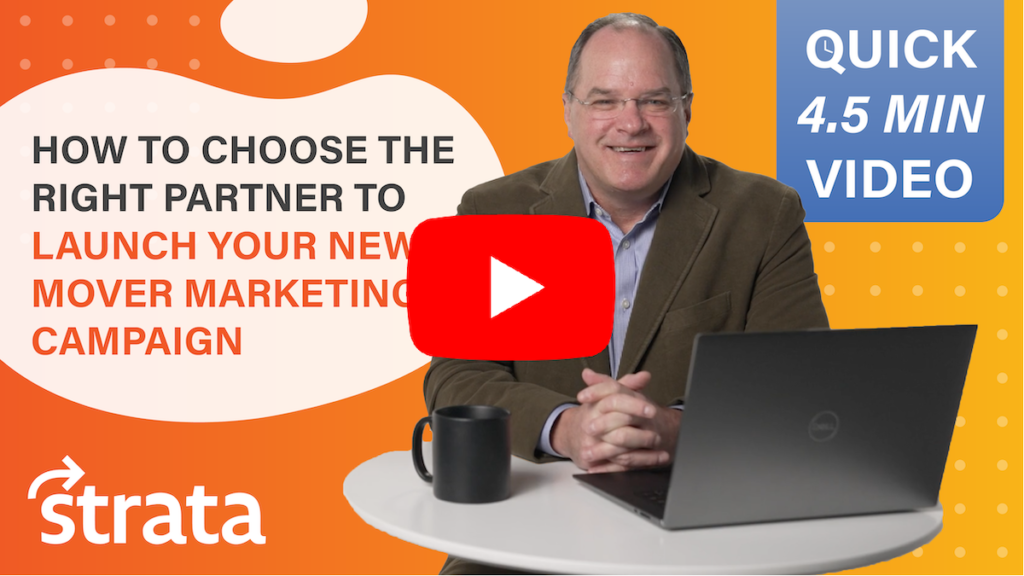
A Strata YouTube Channel Original
New mover marketing is all the rage right now, and for good reason – but getting started can be a bit confusing if you’re new to the game. That’s why in this blog, along with in our most recent YouTube video, we’ll help you achieve a clear understanding of what New Mover Marketing is, and how it could be used for your business. First, we’ll go over how new mover marketing is defined, what a new mover is, and how this marketing technique can be utilized to reach and acquire new customers.
What’s a “New Mover”?
In general, a new mover is someone who’s recently moved to your area, and since they’re new, is looking for a new doctor, dentist, grocery, vet, and more, to establish trust in – and hopefully frequent.
Is New Mover Marketing the Same as Regular Marketing?
In short, no! New mover marketing is a specified, niche tactic that helps you reach new residents in your area while they’re actively establishing new routines and purchasing habits. It’s all about making a strong, quality impression at the same time someone is looking for your services. Different than regular marketing – where you’re mostly informing current customers about new products, services, or promotions, new mover marketing tactics focus solely on bringing in new customers that have just entered your target market.
The Importance of New Mover Marketing
New mover marketing is one of the best ways to gain and retain more customers. If you really think about it, new movers have no customer loyalty to any specific business – yet. They tend to be more receptive and open-minded to marketing campaigns from any business in their new area. They’re also more likely to listen, and are easily attracted to the first business that reaches out to them (so you need to act fast)! Yet, don’t act too fast, because it’s also important to market yourself correctly and effectively. Remember, you typically only get one shot at a first impression, so make sure you present your business the right way.
Let’s quickly go through an example of how exactly a new mover marketing campaign helps you attract new customers. Suppose a new family moves into your town. They’re unfamiliar with what services/businesses are available. Soon after move in, they see a mail campaign for your grocery store in their mailbox. Because they’ll (sooner rather than later) need to go get some groceries, they may be more inclined to visit your store instead of another because you reached out and introduced your store and its services, first. As long as you market yourself correctly, you now have a new, and potentially loyal, customer!
Next Steps
With new mover marketing, the opportunities are endless! Be sure to watch the video, below, to dive a bit deeper. You’ll hear from Strata’s Director of Marketing, Caitlin, as she goes through more specifics. Or, if you’d like to get started on your next new mover marketing campaign and discuss this concept with one of our experts, contact us today.
Is it the Right Option for You?
In a recent blog, we went over what Every Door Direct Mail (EDDM) is, some of its positives and negatives, as well as some alternatives. Today, we’re diving a bit deeper into EDDM’s pros and cons so that, when you’re ready to launch your next direct mail campaign, you’re able to choose wisely.
What is EDDM Again?
Every Door Direct Mail, (better known as “EDDM”) is a blanketed mailing approach sent through USPS to potential customers near your business (aka – all of your “neighbors” nearby). You can use USPS’ provided mapping tool to select a geographic area, while viewing some demographic data based on census reports such as age-range, household size, and income. With this data in mind, you can choose what mail routes you’d like your piece delivered to – and, you guessed it, your mail gets delivered to every door. You can schedule this delivery whenever you’d like, within the parameters of the postal office.
With EDDM, you have the option of either creating the mailer design yourself, or working with a company (like Strata) to create a design that’s effective and professional. And – when using EDDM, you have two options, EDDM Retail and EDDM BMEU.
What’s EDDM Retail?
EDDM Retail is a good option for small businesses, restaurants, realtors, and local political campaigns. With this choice, you can create an account, send 200-5,000 pieces per day, per zip code, and simply drop your mailings off to the post office. You don’t need a permit with this option, and you can easily pay online or at the post office. The cost is currently $0.20 per piece.
What’s EDDM BMEU?
EDDM BMEU, on the other hand, is a good option for larger volume mailings, as there’s no volume limit and you may send to several different zip codes. As you can imagine, it’s slightly more involved than retail. You’ll need to make a Business Customer Gateway account, acquire a bulk mailing permit, and drop off your mailers to a BMEU – a large USPS mail processing center. The current cost for EDDM BMEU can be “as low as $0.168 per piece.”
The Pros of EDDM
Now that you know your EDDM options, we’ll go over the pros and cons. First – the pros. If your marketing budget is low and you’re looking for something that won’t put much of a dent in it, EDDM mailing can be a worthwhile choice. You can avoid high postage rates, generally, and postage discounts are available for most. Additionally, if your mailing is small and you’re not too concerned about a wide geographic area, you can again save on postage by opting for EDDM.
EDDM can work well for general awareness campaigns – such as showcasing a small business’ grand opening, letting people know you’re running for office, hosting a special event at a restaurant, introducing yourself as a realtor…the list goes on. If you want the general public to know about you, EDDM can help you do just that. Just make sure your business and/or brand is apparent by using quality branding and imagery, your logo(s), memorable colors and fonts, and other elements that people will take note of and will recognize if they see them again. If you’re not sure how to do this or what to include, give us a call.
The Cons of EDDM
Although EDDM is a good service that works for a lot of use-cases, it has its downfalls. With EDDM, you’re unable to really target a specified audience based on significant data, such as interests and hobbies, life changes, environment, age, income, and so on. Yes – you can find an area where many of the people meet some of these criteria, but with Every Door Direct Mail – it’s sent to exactly what it sounds like – every door. You don’t have the option to add people in or take people out if they’re in the selected demographic area and on the chosen mail routes. Therefore, you’re likely wasting paper, production, and money on people who have zero interest in your product, service, or event. You could be reaching out to people who fail to check their mail regularly, see your mailer and throw it out immediately, read it over and have no need or interest, or worse, are offended by your offering or service. What do we mean? Here are a few examples of what we liked to call “fail mail”:
- A BBQ restaurant flyer sent to a house of vegans
- A retirement home postcard sent to a couple in their twenties
- A daycare service mailer sent to someone single with no children
- A car dealership flyer sent to an eco-friendly bicyclist
Whether the “potential customer” doesn’t see it, throws it out, doesn’t want it, or is offended by it, the mailer was a waste of time, printing, and money.
On the other hand – maybe your mailer will actually interest most of your audience and you’re sending it to a large target area. Awesome! But – if your EDDM campaign is too large, you risk offsetting postage cost savings with extra production processing. Plus, paper costs right now are higher than normal due to the shortage, which could mean that printing and mailing to every door could cost you more than the response is worth.
Finally, EDDM does not provide the option to truly personalize your mailers. And, if you’ve read any of our other blogs, you know that personalization is a large part of direct mail success. In fact, a personalized CTA has been found to increase conversions by 78.5%. Without including a name, interest, favorite product, specialized offer, or personalized URL and QR code, your response rate is likely to suffer. If the mailer isn’t linked to anything else and doesn’t lead them anywhere personally specific, it’s not nearly as enticing or effective.
Next time you’re looking to send a mailer out to potential customers, fans, voters, guests, and so on, you may want to use EDDM (depending on your budget and needs), but as experts in the industry, we can say that there is often a more targeted strategy, like new mover marketing or multichannel marketing, that may work better. If you’re ready to get started on your next direct mail campaign, we’re here to help. Simply get in touch.
A Strata YouTube Channel Original
Multichannel campaigns can be complicated to create, and once you create them, even more work needs to be put in to make them as effective as possible. In the last YouTube video of our Multichannel Marketing series, we’ll go through how to optimize your multichannel campaign for the best success and highest ROI.
What’s an Optimum Multichannel Campaign?
An optimum multichannel campaign is a campaign or workflow that converts every possible campaign member. Keep in mind – that doesn’t mean every person in the campaign, as there will always be some members that are truly impossible to convert. Why? Things happen. People start new jobs, financial positions change, people move, etc. The list goes on. The point of optimization is to optimize for what can be controlled, and in this instance, that’s the customer journey or workflow.
Two Categories of Multichannel Campaign Optimization
- Theoretical: This category happens before starting your campaign. It’s the last but usually the most time-consuming portion of actually building your workflow. It’s done through effective use of assumptions and historical data from similar campaigns. The steps to do this? Assign estimate conversion rates to each of your workflow components and then use them to calculate expected conversions – taking the output of one component as the input of the next. Although it’s very time consuming, it’s worth it in the end. Theoretical optimization helps you optimize both your campaign and create stronger projections for your campaign’s performance.
- Empirical: This category happens while the campaign runs. Instead of using historical data from other campaigns, you’ll use historical data from this campaign. So, factors like audience and creative can be held constant. You’ll still go through the same process – assigning your empirical conversion rates to each of your components, and going through the calculations to more accurately predict overall campaign outcomes. Measure your component’s KPIs while simultaneously updating projections based on the changes to your workflow.
To hear from our Director of R&D, Harrison, on what else you’ll want to do, as well as what tools you can use to optimize your campaign, click on the video below. Or, if you’d like to discuss multichannel marketing optimization with one of our experts, contact us today.
A Strata YouTube Channel Original
Figuring out your multichannel campaign workflow can be difficult (at first). At its core, a workflow should be a living, breathing thing, and you most likely won’t come up with the optimal flow right from the get-go, and that’s alright, you’re not really supposed to. When building a workflow, your goal should be getting to a point where you’re tweaking it throughout the campaign, not reengineering it. That said, in our most recent YouTube video of our Multichannel Marketing series, we go over best practices for creating this flow, and the ways in which you can make it work well for you and your company.
Are All Workflows the Same?
The answer’s no. Look at the construction of your workflow as an iterative process. Something you sit down with, leave, come back to, leave for another cup of coffee, come back to and test out, make calculations for, leave, come back to, leave for more coffee, etc. Go in with the expectation of optimizing it a handful of times. Remember, it’s personalized to you and your company’s goals.
Its Importance
Having the most effective campaign from the get-go is one thing, but building a workflow and truly thinking through a theory for that workflow is another. It allows you to better test and evaluate your campaign’s goals. If you begin to see a disconnect between your campaign goals and what you currently have after constructing a workflow and calculating your multichannel KPIs, you have a problem. But, the good news is that you can work to solve it before spending money, and possibly disrupting your reputation. This is one of the main reasons workflows are important to have – so you can catch any kinks before launching your campaign.
First Steps
When starting to create your workflow, there are a lot of framework options you can build upon. The video that we’re referring to in this blog is for building a ‘base’ workflow, but, for information on how to tweak your ‘final’ workflow, check out this video when you find some time.
A commonly used workflow strategy formulation starts with defining the highest and lowest levels of the marketing funnel that you want to address. You can have as many ‘funnel buckets’ as you want, and they’ll vary based on your industry and business model. Here are some basic ones that can be used:
- Awareness
- Consideration
- Evaluation
- Purchase
We recommend laying these out as lanes in a flowchart. It helps to visualize the different stages of engagement for your campaign members.
To see next steps for building your multichannel workflow, click on the video below. You’ll hear our Director of R&D, Harrison, go through best practices and tips and tricks for getting yours set up. Or, if you’d like to discuss this concept with one of our multichannel experts, contact us today.


